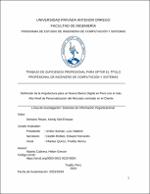| dc.contributor.advisor | Abanto Cabrera, Heber Gerson | |
| dc.contributor.author | Otiniano Reyes, Kendy Stid Enrique | |
| dc.creator | Otiniano Reyes, Kendy Stid Enrique | |
| dc.date.accessioned | 2023-11-21T21:11:50Z | |
| dc.date.available | 2023-11-21T21:11:50Z | |
| dc.date.issued | 2023 | |
| dc.identifier.uri | https://hdl.handle.net/20.500.12759/11431 | |
| dc.description.abstract | En el presente proyecto se abordó la primera fase del MVP del producto tarjeta de crédito digital y la plataforma tecnológica subyacente. Esta fase fue organizada en los siguientes frentes de trabajo: diseño del producto, selección de tecnologías, caso de negocio, estrategia de comercialización y organización para luego pasar a la etapa de construcción del producto.
Para alcanzar el objetivo del proyecto se trabajó en elaborar el blueprint (plano) de arquitectura, la arquitectura de solución e infraestructura objetivo y el flujo de proceso para diseños de arquitecturas de solución.
En este flujo de diseño de arquitectura de solución se identificaron: partes interesadas, insumos, validaciones y entregables que permitan garantizar el cumplimiento de estándares, lineamientos y buenas prácticas a utilizar en la construcción de las funcionalidades de canales, producto o procesos de soporte a cargo de los squads.
Para la gestión del proyecto se tiene un híbrido entre el modelo de Spotify, basados en squads, tribus y chapters, junto con el marco de referencia Scrum para organizar las tareas dentro de cada squad.
En el capítulo 1 se describe la experiencia profesional personal.
En el capítulo 2 se describe el proyecto y un marco teórico del por qué nace tal esfuerzo y la necesidad de este frente a la entrante competencia en el mercado local.
Finalmente, en el Capítulo 3 se detalla el desarrollo del proyecto y explicamos que se realizó en cada frente de trabajo, enfocándonos en el apartado de tecnología y la etapa de construcción. | es_PE |
| dc.description.abstract | This project addressed the first phase of the MVP of the digital credit card product and the underlying technology platform. This phase was organized in the following work fronts: product design, technology selection, business case, marketing strategy and organization, and then moved on to the product construction stage.
To achieve the project's objective, work was done to develop the architecture blueprint, the solution architecture and target infrastructure, and the process flow for solution architecture design.
In this solution architecture design flow, the following were identified: stakeholders, inputs, validations, and deliverables to ensure compliance with standards, guidelines, and best practices to be used in the construction of channel functionalities, product or support processes in charge of the squads.
For project management we have a hybrid between the Spotify model, based on squads, tribes, and chapters, together with the Scrum framework to organize the tasks within each squad.
Chapter 1 describes the personal professional experience.
Chapter 2 describes the project and a theoretical framework of why such an effort was born and the need for it in the face of the incoming competition in the local market.
Finally, Chapter 3 details the development of the project and explains what was done on each work front, focusing on the technology section and the construction stage. | es_PE |
| dc.description.uri | Trabajo de suficiencia profesional | es_PE |
| dc.format | application/pdf | es_PE |
| dc.language.iso | spa | es_PE |
| dc.publisher | Universidad Privada Antenor Orrego | es_PE |
| dc.relation.ispartofseries | T_SIST_1524 | |
| dc.rights | info:eu-repo/semantics/closedAccess | es_PE |
| dc.rights.uri | https://creativecommons.org/licenses/by/4.0/ | es_PE |
| dc.source | Universidad Privada Antenor Orrego | es_PE |
| dc.source | Repositorio Institucional - UPAO | es_PE |
| dc.subject | Banco Digital | es_PE |
| dc.subject | Mercado | es_PE |
| dc.title | Definición de la Arquitectura para un Nuevo Banco Digital en Perú con el más Alto Nivel de Personalización del Mercado centrado en el Cliente | es_PE |
| dc.type | info:eu-repo/semantics/bachelorThesis | es_PE |
| thesis.degree.level | Título Profesional | es_PE |
| thesis.degree.grantor | Universidad Privada Antenor Orrego. Facultad de Ingeniería | es_PE |
| thesis.degree.name | Ingeniero de Computación y Sistemas | es_PE |
| thesis.degree.discipline | Ingeniería de Computación y Sistemas | es_PE |
| dc.subject.ocde | https://purl.org/pe-repo/ocde/ford#2.02.04 | es_PE |
| renati.advisor.orcid | https:// orcid.org/0000-0001-9320-806X | es_PE |
| renati.author.dni | 47297890 | |
| renati.advisor.dni | 18107335 | |
| renati.type | https://purl.org/pe-repo/renati/type#tesis | es_PE |
| renati.level | https://purl.org/pe-repo/renati/level#tituloProfesional | es_PE |
| renati.discipline | 611066 | es_PE |
| renati.juror | Urrelo Huiman, Luis Vladimir | |
| renati.juror | Castillo Robles, Edward Fernando | |
| renati.juror | Infantes Quiroz, Freddy Henrry | |
| dc.publisher.country | PE | es_PE |




